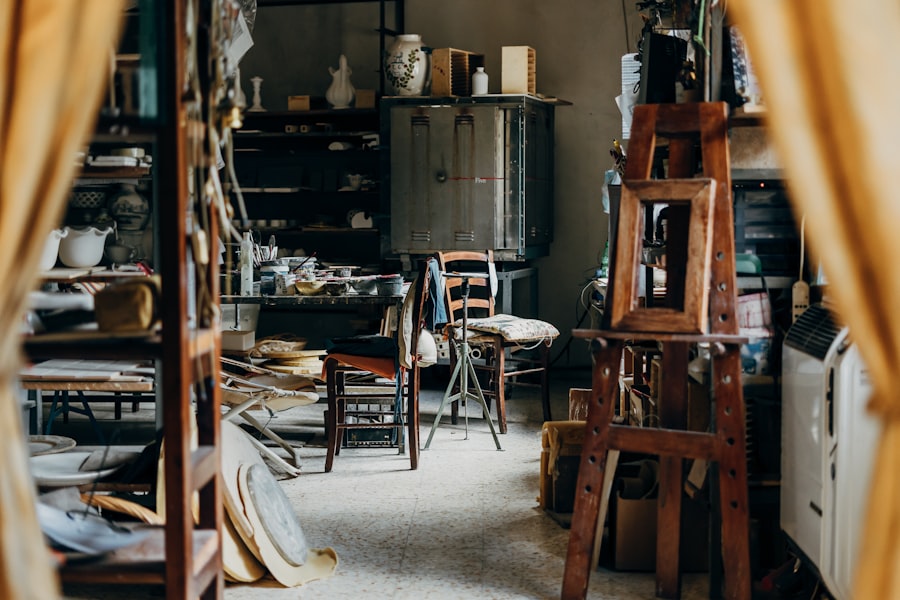When embarking on the journey of creating my dream patio, the first step I took was to carefully consider the materials I would use. The choice of materials can significantly influence not only the aesthetic appeal of the space but also its durability and maintenance requirements. I found myself drawn to natural stone and brick for their timeless beauty and resilience.
These materials not only provide a rustic charm but also withstand the elements, making them ideal for outdoor settings. I spent hours researching various options, weighing the pros and cons of each, and ultimately decided on a combination of flagstone and pavers that would complement my home’s architecture. In addition to stone and brick, I also explored other materials such as concrete and wood.
Concrete offers versatility and can be molded into various shapes, while wood brings warmth and a natural feel to the patio. However, I was mindful of the maintenance that wood requires, especially in terms of weatherproofing and potential rot. After much deliberation, I settled on a mix of materials that would not only enhance the visual appeal of my patio but also ensure longevity.
I learned that choosing the right materials is not just about aesthetics; it’s about creating a space that I can enjoy for years to come without constant upkeep.
Key Takeaways
- Choose durable and weather-resistant materials for your patio to ensure longevity and low maintenance.
- Design a functional layout that complements your outdoor space and allows for easy movement and entertainment.
- Properly prepare the foundation of your patio to ensure stability and prevent shifting or sinking over time.
- Ensure proper drainage and grading to prevent water accumulation and potential damage to your patio.
- Select furniture and decor that is suitable for outdoor use and complements the overall design of your patio.
Designing a Functional Layout
Once I had selected my materials, the next step was to design a functional layout that would maximize the use of my patio space. I began by envisioning how I wanted to use the area—whether for entertaining guests, relaxing with a book, or enjoying family meals outdoors. This vision guided my design choices as I mapped out different zones within the patio.
I realized that creating distinct areas for dining, lounging, and cooking would enhance both functionality and flow. By sketching out my ideas on paper, I was able to visualize how each section would come together harmoniously. In addition to zoning, I also considered traffic patterns and accessibility.
It was important for me to ensure that pathways were clear and that movement between different areas felt natural. I incorporated features such as built-in seating and a fire pit to create inviting focal points while maintaining open spaces for easy navigation. As I worked through the design process, I found that balancing aesthetics with practicality was key.
Ultimately, my goal was to create a patio that not only looked beautiful but also served as a welcoming retreat for family and friends.
Preparing the Foundation

With my layout in place, I turned my attention to preparing the foundation for my patio. This step is crucial, as a solid foundation ensures stability and longevity for the entire structure. I began by clearing the area of any debris, grass, or weeds, which allowed me to start with a clean slate.
After leveling the ground, I laid down a base layer of gravel to promote drainage and prevent settling over time. This process required careful attention to detail, as any imperfections in the foundation could lead to issues down the line. Next, I compacted the gravel thoroughly to create a firm surface before laying down sand as a bedding layer for my chosen materials.
This step was essential for achieving a level finish and ensuring that my pavers would fit snugly together. As I worked on this part of the project, I realized how important it was to take my time and do things right.
By investing effort into this stage, I felt confident that my patio would stand the test of time.
Proper Drainage and Grading
| Aspect | Metric | Measurement |
|---|---|---|
| Proper Drainage | Surface Water Runoff | Percentage of water effectively drained |
| Grading | Slope | Measurement of the incline of the land |
| Proper Drainage | Drainage System Capacity | Volume of water the system can handle |
| Grading | Evenness | Uniformity of the land’s surface |
One of the most critical aspects of patio construction that I learned about was proper drainage and grading. Without adequate drainage, water can accumulate on the surface or seep into the foundation, leading to potential damage over time. To address this concern, I researched various drainage solutions and decided to incorporate a slight slope in my patio design.
This slope would direct water away from my home and towards designated drainage areas. I also installed drainage channels along the edges of the patio to further manage water runoff effectively. As I worked through this process, I became increasingly aware of how essential it is to consider local weather patterns and soil conditions when planning drainage solutions.
By taking these factors into account, I felt reassured that my patio would remain functional even during heavy rainstorms. Ensuring proper drainage not only protects my investment but also enhances the overall usability of my outdoor space.
Selecting the Right Furniture and Decor
With the structural elements of my patio complete, it was time to focus on selecting furniture and decor that would bring my vision to life. I wanted to create an inviting atmosphere where family and friends could gather comfortably. After exploring various styles and materials, I opted for weather-resistant furniture that would withstand outdoor conditions while still providing comfort and style.
A cozy sectional sofa paired with a rustic coffee table became the centerpiece of my lounging area. In addition to furniture, I paid close attention to decor elements such as cushions, throws, and outdoor rugs. These accessories added color and texture while enhancing the overall ambiance of the space.
I also incorporated personal touches like potted plants and decorative lanterns to create a warm and welcoming environment. As I arranged each piece thoughtfully within my layout, I felt a sense of satisfaction knowing that every element contributed to making my patio feel like an extension of my home.
Adding Lighting and Greenery

To truly elevate my patio experience, I recognized the importance of incorporating lighting and greenery into the design. Outdoor lighting not only enhances safety but also sets the mood for evening gatherings. I chose a combination of string lights and solar-powered lanterns to create a warm glow that would invite guests to linger long after sunset.
The soft illumination transformed my patio into a magical retreat at night. In addition to lighting, adding greenery was essential for creating a vibrant atmosphere. I selected a variety of plants that thrived in my climate, including colorful flowers and lush foliage.
By strategically placing planters around the patio, I was able to create visual interest while also providing natural beauty. The combination of lighting and greenery brought life to my outdoor space, making it feel inviting and serene.
Maintaining and Cleaning Your Patio
As much as I enjoyed designing and building my patio, I quickly learned that maintaining it is equally important for preserving its beauty and functionality. Regular cleaning became part of my routine; sweeping away debris and hosing down surfaces helped prevent dirt buildup and staining. For tougher stains or grime, I discovered that using a gentle cleaner specifically designed for outdoor surfaces worked wonders without damaging my materials.
Seasonal maintenance also became essential in keeping my patio looking its best. In spring, I focused on refreshing plants and checking for any wear on furniture or fixtures. During fall, clearing leaves from surfaces ensured proper drainage during rainy months.
As I navigated through each stage of my patio project, I often pondered whether hiring a professional or taking a DIY approach was best for me. While there are undeniable benefits to enlisting experts—such as their experience and access to specialized tools—I found immense satisfaction in tackling many aspects myself. The DIY approach allowed me to personalize every detail according to my vision while also saving costs.
However, there were moments when I recognized the value of professional assistance—particularly when it came to complex tasks like grading or drainage installation. In those instances, collaborating with skilled contractors provided peace of mind knowing that critical elements were handled correctly. Ultimately, striking a balance between DIY efforts and professional help allowed me to create a beautiful patio tailored to my needs while ensuring quality craftsmanship throughout the process.
In conclusion, creating my dream patio has been an enriching experience filled with learning opportunities at every turn. From choosing materials to designing layouts and maintaining the space, each step has contributed to making this outdoor retreat truly special. Whether one opts for a DIY approach or seeks professional guidance, what matters most is crafting an environment that reflects personal style while providing comfort and enjoyment for years to come.
If you are interested in learning more about how smart technology can enhance your outdoor living space, check out this article on smart technology for patios. This article discusses how incorporating smart features into your patio construction can revolutionize the way you enjoy your outdoor space.
FAQs
What is patio construction?
Patio construction involves the process of building an outdoor space, typically paved, that is used for dining, entertaining, or relaxation.
What materials are commonly used in patio construction?
Common materials used in patio construction include concrete, brick, stone, pavers, and wood. Each material has its own advantages and can be chosen based on the desired aesthetic and functionality.
What are the benefits of having a patio?
Having a patio provides an outdoor space for relaxation, entertainment, and dining. It can also increase the value of a property and enhance the overall aesthetics of the outdoor area.
What are some important considerations for patio construction?
Important considerations for patio construction include the size and layout of the patio, the choice of materials, drainage, and any necessary permits or regulations.
How long does patio construction typically take?
The timeline for patio construction can vary depending on the size, materials, and complexity of the project. However, a typical patio construction project can take anywhere from a few days to a few weeks to complete.
Do I need a professional for patio construction?
While some homeowners may choose to tackle patio construction as a DIY project, hiring a professional contractor is often recommended to ensure proper design, construction, and adherence to local building codes and regulations.
